|
Maritime history is filled with stories of great sailing ships, plying the massive oceans of the world, run by rugged, swaggering, masculine sailors. It may be that the 19th century sailing vessel was a male dominated and defined world, yet women are assuredly part of this rich history. For different reasons women through the centuries have stepped outside the status quo, beyond societal definitions of what is suitably feminine. These reasons included responding to dire emergencies while at sea, patriotic wartime duty, economic necessity, a chance at a better life, search for adventure, devotion, and love. Women in the Age of Sail Seagoing careers were closed to women during the sailing ship era. A woman might disguise herself as a man and assume a fictitious name; but if she was discovered, her career would be over. The only way for most women to take part in running a merchant vessel before 1900, when sailing ships reigned supreme, was through marriage or by being the captain’s daughter. The captain’s wife might have learned the art of navigation in a girl’s finishing school, or from her husband or one of the mates (officers). 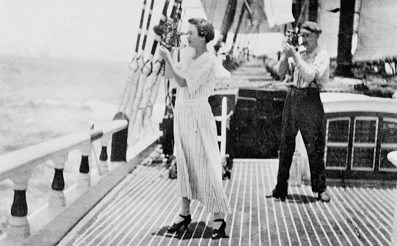
NPS SAFR J09.08059 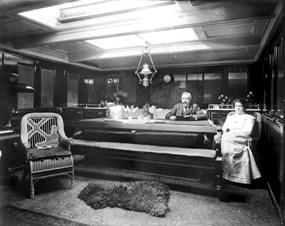
Wilhelm Hester Collection The captain and his wife in their cabin. If she was interested, and the captain allowed it, his wife might assist him in running the ship. Usually when a captain's daughter grew into her teens, she was forbidden to take part in sailor's work; she was expected to be a lady. The children were not allowed to go forward of the poop deck (the captain's deck at the stern or back end of the vessel). However, father may have looked the other way when his son sneaked forward to lend the sailors a hand. On British ships the captain could hire his wife as an officer or stewardess, or the first mate's wife might be the stewardess. The stewardess kept financial records, served meals, and cleaned the after-quarters. Through diaries and letters, a picture can be composed of women and girls aboard sailing vessels. Eight year old Laura Jernegan wrote this letter , (Laura Jernegan's March 6, 1870 letter to her grandmother in Edgartown, Martha's Vineyard. Courtesy of the Nicholson Whaling Collection, Providence Public Library.) while sailing with her father, Captain Jared Jernegan aboard the whaling bark Roman. Laura at age eight (photo courtesy of the Martha's Vineyard Historical Society) In emergencies the captain's wife might lend a hand. Caroline Mayhew, wife of Captain William Mayhew of the whaling ship Powhaton out of Martha's Vineyard, possessed a working knowledge of navigation and practical medicine. In 1846 when a small pox epidemic broke out aboard ship, she took over as captain in place of her stricken husband. She then ministered to him and the ailing crew, saving their lives. Medicine chest of a sea captain. 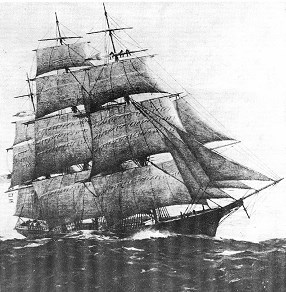
NPS Heroines, Homemakers and Hard Workers During the nineteenth century several women took on responsibilities that were considered exclusively in the realm of men, and gained worldwide attention for their heroic actions. Others, because of economic necessity, stepped beyond stereotypical roles as wives and mothers. 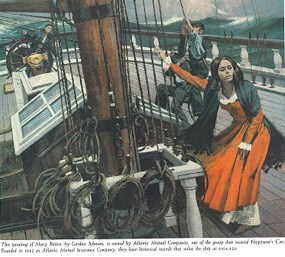
Atlantic Mutual Companies Mistrusting the first mate, the captain removed him from his position and took on his duties. As the ship was rounding Cape Horn, Captain Patten fell ill, his hearing and eyesight failing. Next in line for command was the second mate, but he could not navigate. Mary Patten assumed command, with the second mate's help and the support of the crew. Navigating and caring for her husband filled every moment; for fifty days she was unable to change clothes. The ship arrived in San Francisco November 1856. The insurers of the vessel rewarded her with one thousand dollars. Mary Patten and her husband returned to New York where she gave birth to a son. Sadly, her husband died three months later. 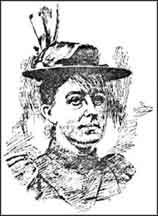
SAFR HDC 1113 Eliza Thorrold continued to operate the 44-foot steam tug Ethel and Marion on the San Francisco Bay after her husband, Captain Charles Thorrold, died from blood poisoning in 1893. Even though she controlled the tug, the law required that a licensed master be on board if the vessel was transacting business. By 1900 Eliza had sold the tug, and in 1915 she and her son opened a neighborhood ice cream and candy store which she operated until her death in 1935. Alice Durkee, wife of Alfred Durkee who was captain of the Balclutha from 1894-1899, sailed with her husband on and off during his 30-year seafaring career. She gave birth to a daughter, Inda Francis, on board the ship. In the Shipyard In 1562 Dutch widow Geert Jans inherits a shipyard from her husband and runs the yard. In 1770 Mary Lacy, disguised as a man, receives her shipwright certificate in England and works among male shipbuilders. In the 1940s Mrs. Fulton inherits and operates her husband's shipyard north of San Francisco. Aside from such exceptions, only widespread wars brought women to shipbuilding. 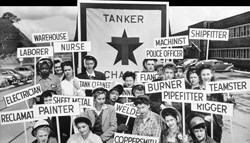
SAFR P83,103.69 In mid-l943 at the height of the shipbuilding boom, nearly 65% of the shipyard workers on the West Coast were women. However, few women held leadership positions such as foreman or supervisor over men or mixed workers. "The war made me live better, it really did. My sister always said that Hitler was the one that got us out of the white folks' kitchen", said Tina Hill who worked at North American Aircraft in Los Angeles during World War II. (Quote from Rosie the Riveter by Penny Colman). Of all the minority groups, African-American women experienced the greatest difficulty in finding work during the war. Early on, they were hired as custodians, cooks, and food servers. Towards the end of the war, labor shortages were so acute that they were accepted in ship production - but only in lower-skilled positions. Many men on the home front and abroad feared that women might want to continue their financial and social independence after the war. However, the vast majority of women were dismissed from traditionally male jobs, returning to their previous lives. Shipyard work became a boon not only for white women; but for Asians, Latinas, and African Americans. As never before, women as a whole had experienced financial and social independence by the end of the war. One Marinship woman worker noted that the shipyard experience "…made women confident. It has given us a sense of self-security …Because I have been able to engage in war work, I'll never again feel helpless." Historian Susan M. Hartman stated that the l940s "…laid the preconditions for an awakened womanhood in the l960s." (Quotes from Marinship at War by Charles Wollenberg). Little did women realize that World War II would change their lives dramatically. Women would "make sparks" as never before simply in replacing men in the work force. Now we look back at these shipbuilders of World War II and honor their enormous contributions. Because the job was easiest to perform and demanded the least physical effort, women were hired primarily as welders (photo info: P82.125a.6000) at the beginning. As the war continued, the need for women shipbuilders was so great that companies began to test women in a wide variety of production jobs. It was found that they could perform not only competently, but many women performed better than men in the same job. Women at the Helm During the Age of Sail the best way for a woman to get a job aboard a ship was to disguise herself as a man. Women no longer have to masquerade as men to pursue a career on the water but still face many challenges in a male-dominated field. Despite these challenges, more and more women are pursuing their dreams, honing their skills, and making a living in maritime industries. |
Last updated: March 10, 2024
